Bhoneycutt87 (talk | contribs) |
No edit summary |
||
| (13 intermediate revisions by 4 users not shown) | |||
| Line 24: | Line 24: | ||
{{Quote|My armour is like tenfold shields, my teeth are swords, my claws spears, the shock of my tail is a thunderbolt, my wings a hurricane, and my breath death!|''[[The Hobbit]],'' [[Inside Information]]}} |
{{Quote|My armour is like tenfold shields, my teeth are swords, my claws spears, the shock of my tail is a thunderbolt, my wings a hurricane, and my breath death!|''[[The Hobbit]],'' [[Inside Information]]}} |
||
| − | '''Smaug''' was a [[Fire drakes|fire drake]] of the [[Third Age]], considered to be the last great dragon to exist in Middle Earth. Drawn to the enormous wealth amassed by the [[dwarves]] of [[Erebor]] in the [[Lonely Mountain]] during the reign of King [[Thror]], he laid waste to the neighboring city of [[Dale]] and captured Erebor, driving the survivng dwarves into exile |
+ | '''Smaug''' was a [[Fire drakes|fire drake]] of the [[Third Age]], considered to be the last great dragon to exist in Middle Earth. Drawn to the enormous wealth amassed by the [[dwarves]] of [[Erebor]] in the [[Lonely Mountain]] during the reign of King [[Thror]], he laid waste to the neighboring city of [[Dale]] and captured Erebor, driving the survivng dwarves into exile. |
| + | |||
| + | For almost two hundred years, Smaug hoarded Erebor's treasures to himself and ruled within the Lonely Mountain, until a [[Thorin and Company|company of dwarves]] managed to enter Erebor and drive him out of hiding. Correctly believing that the dwarves had received assistance from the men of [[Lake-town]] in entering Erebor, Smaug left the mountain to wreak destruction upon Lake-town, nearly decimating it before being slain [[Bard the Bowman]]. |
||
==Biography== |
==Biography== |
||
| Line 33: | Line 35: | ||
[[File:Smaug.jpg|thumb|250px|Smaug in the original illustration by J.R.R. Tolkien.]] |
[[File:Smaug.jpg|thumb|250px|Smaug in the original illustration by J.R.R. Tolkien.]] |
||
| − | In TA 2770, Smaug came from the mountains in the north, drawn by great wealth amassed by the dwarven kingdom of Erebor, which included [[Gold|gold]], g[[Gems|emstones]], m[[Mithril|ithril]], s[[Silver|ilver]], pearls, the many-faceted crystals of emerald, sapphire and diamond, and the famed [[Arkenstone]]. Seeking to claim the mountain and its treasures for himself, Smaug completely |
+ | In TA 2770, Smaug came from the mountains in the north, drawn by great wealth amassed by the dwarven kingdom of Erebor, which included [[Gold|gold]], g[[Gems|emstones]], m[[Mithril|ithril]], s[[Silver|ilver]], pearls, the many-faceted crystals of emerald, sapphire and diamond, and the famed [[Arkenstone]]. Seeking to claim the mountain and its treasures for himself, Smaug completely destroyed the neighboring city of [[Dale]] in a great firestorm before turning to Erebor itself, smashing through the great doors of the Lonely Mountain, slaying those who resisted him and forcing the surviving dwarves into exile. |
| − | For two centuries, Smaug ruled the Lonely Mountain uncontested, lying within the great treasure hoard of Erebor and ensuring no one entered the mountain in an attempt to steal from him. The surrounding doman became a scarred wasteland known to the dwarves and men as the Desolation of Smaug, and the city of Dale |
+ | For two centuries, Smaug ruled the Lonely Mountain uncontested, lying within the great treasure hoard of Erebor and ensuring no one entered the mountain in an attempt to steal from him. The surrounding doman became a scarred wasteland known to the dwarves and men as the Desolation of Smaug, and the city of Dale remained a blasted ruin and a grim reminder of the dragon's terrible power. Yet in the year [[TA 2941]], a [[Thorin and Company|company of fourteen adventurers]] consisting of twelve dwarves, the wizard [[Gandalf]], the [[hobbit]] [[Bilbo Baggins]], and led by the heir of Erebor, [[Thorin Oakenshield]], entered Smaug's mountain lair by a secret door in a daring attempt to reclaim the mountain from the dragon. |
[[File:Smaug_and_Bilbo.png|thumb|left|250px|Smaug having a conversation with [[Bilbo Baggins]].]] |
[[File:Smaug_and_Bilbo.png|thumb|left|250px|Smaug having a conversation with [[Bilbo Baggins]].]] |
||
| − | Bilbo, the company's appointed "burglar," is sent into the treasure chamber alone in an attempt to stealthily gather intel and steal what he can without waking Smaug. Once there, Bilbo is surprised |
+ | Bilbo, the company's appointed "burglar," is sent into the treasure chamber alone in an attempt to stealthily gather intel and steal what he can without waking Smaug. Once there, Bilbo is surprised to find that Smaug was much larger than he had expected and covered in impenetrable armor, save for his underbelly. Aware of this vulnerability, Smaug deliberately spent years sprawled on the wealth of his hoard, allowing diamonds and hard gemstones to be embedded into his belly, armoring his only weakness. However, while examining the dragon, Bilbo noticed a single bare patch on the monster's left breast, nearest his heart. With this invaluable information, he escaped the dragon's lair and returns to the dwarves, sharing his discovery of Smaug's weakness with them, unaware that he was overheard by a [[thrush]], who carried the secret to Bard the Bowman in nearby [[Esgaroth]], also known as [[Lake-town]]. |
[[File:Ss hobbit-smaug-06.jpg|thumb|250px|Smaug's missing scale.]] |
[[File:Ss hobbit-smaug-06.jpg|thumb|250px|Smaug's missing scale.]] |
||
| − | Returning to the treasure chamber, Bilbo attempts to steal a single cup, but its theft is immediately noted by Smaug, who |
+ | Returning to the treasure chamber, Bilbo attempts to steal a single cup, but its theft is immediately noted by Smaug, who awakens from his slumber. Amused by the Hobbit, Smaug converses with Bilbo, attempting to deduce his origins and purpose in the mountain. He quickly surmises that Bilbo was aiding Thorin and the rest of the Dwarf company in an attempt to steal back the Arkenstone and reclaim the Mountain. Smaug flies into a rage, erupting from the mountain in a fiery wrath and loosing his flame upon the land. He flies to Esgaroth upon the [[Long Lake]] and devastates it. In the midst of the wreck, [[Bard the Bowman]], heir to the throne of Dale, does his best to rally men to repel the dragon's assault. Bard, guided by his knowledge of Smaug's secret weakness, fires a black arrow into the beast's vulnerable spot on his belly. Roaring in fury and pain, Smaug falls from the sky and crashes into the flaming ruins of Lake-town, his death signaling the end of the presence of dragons in Middle Earth. |
===After Death=== |
===After Death=== |
||
| Line 59: | Line 61: | ||
==Size== |
==Size== |
||
| − | + | Smaug's actual size is indeterminate as it is never explicitly mentioned in the The Hobbit. In ''The Atlas of Middle-Earth'' by Karen Wynn Fonstad<ref>Karen Wynn Fonstad, 2002, The Atlas of Middle-Earth, Houghton Mifflin</ref>, Smaug is said to be about '''20'''''' meters''' (65 feet) in length. This measurement corresponds with drawings by Tolkien in which Smaug seems to be around 25 meters (86 feet). For the size described in the film works, see below. |
|
| − | It is unclear whether Smaug, the largest specimen in the Third Age, would compete in mightiness to his ancestors of average size in the [[First Age]]. |
+ | It is unclear whether Smaug, the largest specimen in the Third Age, would compete in mightiness to his ancestors of average size in the [[First Age]], though he was clearly smaller than [[Ancalagon]], the largest known dragon to have existed. |
==Abilities== |
==Abilities== |
||
[[File:Smuag4.png|thumb|250px|Smaug getting ready to shoot fire at Bilbo.]] |
[[File:Smuag4.png|thumb|250px|Smaug getting ready to shoot fire at Bilbo.]] |
||
| − | Being a fully-grown dragon, Smaug was massive and powerful |
+ | Being a fully-grown dragon, Smaug was both massive and powerful, possessing physical strength great enough to crush stone with ease, as seen by his attack on Erebor. He was able to fly thanks to his large wings, and had the ability to breath streams of searing hot flame from his mouth. Some comments in ''The Hobbit'' imply that his entire body was imbued with fire, as he was seen to glow in the darkness of the Lonely Mountain's depths, and his usual paths were said to have been "smoothed and slimed" (i.e. melted) by his passage. |
Like many dragons of Middle-earth, Smaug's monstrous appearance also belied keen senses and a dangerously sharp mind. He had an encyclopedic knowledge of his treasure hoard, immediately registering the theft of a single cup after Bilbo made his first visit to his lair. When the hobbit returned a second time, Smaug was already expecting him by feigning sleep, and immediately declared that he could sense the thief even if he could not see him. Although Bilbo was clever enough not to fall for Smaug's attempts to trick him into revealing his exact position, the dragon used the resulting conversation to plant doubts in Bilbo's mind, correctly guessing that the "burglar" had allied himself with the dwarves and the men of Lake Town and asking if Bilbo had ever considered the logistical difficulties of getting his share of Smaug's treasure back to his home. |
Like many dragons of Middle-earth, Smaug's monstrous appearance also belied keen senses and a dangerously sharp mind. He had an encyclopedic knowledge of his treasure hoard, immediately registering the theft of a single cup after Bilbo made his first visit to his lair. When the hobbit returned a second time, Smaug was already expecting him by feigning sleep, and immediately declared that he could sense the thief even if he could not see him. Although Bilbo was clever enough not to fall for Smaug's attempts to trick him into revealing his exact position, the dragon used the resulting conversation to plant doubts in Bilbo's mind, correctly guessing that the "burglar" had allied himself with the dwarves and the men of Lake Town and asking if Bilbo had ever considered the logistical difficulties of getting his share of Smaug's treasure back to his home. |
||
| Line 76: | Line 78: | ||
==Personality== |
==Personality== |
||
| − | Smaug is portrayed as being arrogant, and greedy, |
+ | Smaug is portrayed as being psychopathic, arrogant, and greedy, possessing an unquenchable desire for gold. His most distinguishing characteristic (aside from his greed) is his arrogance, as Smaug proudly boasts of his superiority and impregnability to Bilbo during their encounter. However, this proves to be his downfall, as he unwittingly reveals the weak spot in his chest to Bilbo when showing the Hobbit how he had willfully coated his underbelly in treasure to protect it. |
| + | |||
| + | Smaug seems primarily motivated by personal greed rather than a desire to do evil, and does not seem to serve any allegiance other than his own. While he does ruthlessly destroy Dale and lays waste to the dwarves of Erebor during his attack on the Lonely Mountain, once he has assumed dominion of the region he seems content to allow the rest of Middle Earth to go about its business, so long as he or his treasure remains undisturbed. Highly intelligent, Smaug appears to possess a rather sardonic sense of humor, darkly mocking Bilbo while they converse within Erebor's treasure chamber. Smaug seems to dislike dwarves, considering them to be weak and pathetic creatures far beneath him, making unfavorable comments about [[Thror]] and showing no remorse over his slaughter of their kind and claiming of their kingdom. While conversing with Bilbo, Smaug is also able to quickly surmise the reason for Bilbo's presence in Erebor, and also correctly deduces that the dwarves received aid from the men of Esgaroth in reaching the mountain. |
||
==Portrayal in adaptations== |
==Portrayal in adaptations== |
||
| Line 83: | Line 87: | ||
{{Quote|I am fire. I am...death.|Smaug, [[The Hobbit: The Desolation of Smaug|Desolation of Smaug]]}} |
{{Quote|I am fire. I am...death.|Smaug, [[The Hobbit: The Desolation of Smaug|Desolation of Smaug]]}} |
||
| − | Smaug is voiced and interpreted with performance capture by [[Benedict Cumberbatch]] in Peter Jackson's [[The Hobbit (films)|three-part adaptation of ''The Hobbit.'']] Smaug is presented with a long head, red scales, enormous wings and |
+ | Smaug is voiced and interpreted with performance capture by [[Benedict Cumberbatch]] in Peter Jackson's [[The Hobbit (films)|three-part adaptation of ''The Hobbit.'']] Smaug is presented with a long head, red scales, enormous wings, and gleaming yellow eyes. The dragon has a deep, resonant voice with an underlying growl. |
{{Quote|I am king under the mountain.|Smaug, [[The Hobbit: The Desolation of Smaug|Desolation of Smaug]]}} |
{{Quote|I am king under the mountain.|Smaug, [[The Hobbit: The Desolation of Smaug|Desolation of Smaug]]}} |
||
| Line 91: | Line 95: | ||
{{Spoiler}} |
{{Spoiler}} |
||
| − | In the second film, ''[[The Hobbit: The Desolation of Smaug]],'' Smaug is awoken as Bilbo hunts for the [[Arkenstone]] amongst the vast treasure pile. Although Bilbo uses the [[One Ring]] to remain out of sight, the dragon is immediately made aware of his presence by his scent. As he searches for Bilbo, he hints at an awareness of the |
+ | In the second film, ''[[The Hobbit: The Desolation of Smaug]],'' Smaug is awoken as Bilbo hunts for the [[Arkenstone]] amongst the vast treasure pile of Erebor. Although Bilbo uses the [[One Ring]] to remain out of sight, the dragon is immediately made aware of his presence by his scent. As he searches for Bilbo, he hints at an awareness of the Ring in Bilbo's possession, claiming that he senses that Bilbo has something "made of gold, but far more precious," which in turn forces the hobbit to remove the ring in front of him. During their conversation. Smaug reveals that he had already known about Thorin's plans to reclaim the [[Lonely Mountain]] (possibly because of the [[Thrush]] knocking the entrance to the heart of the mountain in the first film). Smaug also reveals his knowledge of the growing threat from Sauron (though he doesn't name him), stating that the quest to reclaim Erebor is ultimately futile as Sauron is preparing to openly declare himself once more. Smaug quickly discerns the Hobbit's true intentions to steal the Arkenstone from him, and claims that he is almost tempted to let Bilbo take it in order to watch it consume Thorin as it did Thror. At this point Smaug tires of their cat-and-mouse banter and immediately tries to eat Bilbo, but Bilbo uses the ring to evade him, causing Smaug to fly into a rage and unleash a torrent of flames around the treasure chamber in an attempt to roast the hobbit alive before he can escape. |
| ⚫ | Smaug catches up to Bilbo and the dwarves, but they manage to elude him, and he begins silently stalking the abandoned halls in search of them. Upon realizing he is blocking their only path out of the mountain, the dwarves hatch a desperate plan to lead Smaug to Erebor's forges in hopes that they can trick him into rekindling the smelting vats with his fire breath. They reveal themselves to Smaug, initiating a perilous game of cat an mouse through the halls of the mountain, doing everything in their power to encumber the pursuing dragon as they race towards the entrance to Erebor. As Bilbo leads the dragon inot the Gallery of the Kings, he is quickly overrun by Smaug, who deduces that Bilbo and the Dwarves were aided by the men of Esgaroth, and leaves to destroy the town. As he is leaving, Thorin appears and taunts him, unveiling an enormous, freshly casted golden statue of a dwarf, which distracts the greedy dragon long enough for the statue to melt into liquid gold and engulf him. However, Smaug survives the scalding gold and erupts from the molten pool, roaring that he will show the dwarves what revenge really is. He then breaks through the walls of the mountain, shakes off his gold coating, and takes flight. Smaug flies off towards Lake-town, and the film ends with him uttering "I am Fire, I am.....Death!" as he soars towards the unsuspecting town, leaving Bilbo and the others in horror at what they have unleashed. |
||
| ⚫ | The film deviates from the book in portraying Smaug's underbelly as being heavily armored as the rest of him, rather than being artificially protected by a coat of gold and gems. The bare patch that Bilbo notices is a single missing scale instead, broken off during his attack on Dale, by one of the |
||
| − | |||
| ⚫ | Smaug catches up to Bilbo and the |
||
{{Endspoiler}} |
{{Endspoiler}} |
||
| Line 103: | Line 105: | ||
Smaug was considered the highlight of the second film of the series with several critics hailing it as cinema's greatest dragon incarnation. Universal praise was also given to the visual effects company [[Weta Workshop|Weta]] Digital and the vocal and motion-capture performance of Cumberbatch for bringing a fully realized personality to Smaug. |
Smaug was considered the highlight of the second film of the series with several critics hailing it as cinema's greatest dragon incarnation. Universal praise was also given to the visual effects company [[Weta Workshop|Weta]] Digital and the vocal and motion-capture performance of Cumberbatch for bringing a fully realized personality to Smaug. |
||
| − | ==== |
+ | ====Movie Abilities==== |
[[File:The-hobbit-reveals-dragon-smaug.jpg|thumb|right|250px|Smaug's liquid-flame in the first film.]] |
[[File:The-hobbit-reveals-dragon-smaug.jpg|thumb|right|250px|Smaug's liquid-flame in the first film.]] |
||
It is possible that he can change how his fire-breath comes out, depending on the usages. In the first film, his fire was more liquid and napalm-like, which had enough power and mass to shatter stone buildings and its blast could spread on the ground. In the second film, his fire is somewhat of a more typical fire or gas-fueled flamethrower-like with immense firepower enough to engulf his own body. It is possible that his breath in the second movie was normal fire because his priority was to kill the intruders, and not to cause destruction, understandably his treasures. |
It is possible that he can change how his fire-breath comes out, depending on the usages. In the first film, his fire was more liquid and napalm-like, which had enough power and mass to shatter stone buildings and its blast could spread on the ground. In the second film, his fire is somewhat of a more typical fire or gas-fueled flamethrower-like with immense firepower enough to engulf his own body. It is possible that his breath in the second movie was normal fire because his priority was to kill the intruders, and not to cause destruction, understandably his treasures. |
||
| − | ==== |
+ | ====Movie Size==== |
[[File:Making-of-Smaug-by-Weta-Digital-for-The-Hobbit-The-Desolation-of-Smaug-8.jpg|thumb|left|250px|Smaug's size comparison with Boeing 747 in making.]] |
[[File:Making-of-Smaug-by-Weta-Digital-for-The-Hobbit-The-Desolation-of-Smaug-8.jpg|thumb|left|250px|Smaug's size comparison with Boeing 747 in making.]] |
||
| Line 115: | Line 117: | ||
====Film Continuity==== |
====Film Continuity==== |
||
| − | [[File:Desolation-of-Smaug-Movie-Dragon.jpg|thumb|200px|Smaug |
+ | [[File:Desolation-of-Smaug-Movie-Dragon.jpg|thumb|200px|Smaug under his treasure.]] |
| − | |||
| − | In the film ''An Unexpected Journey'' Smaug is shown with blue-hued scales when his eye opens in the closing moments of the film. This seems contradictory to Smaug's crimson scales in ''The Desolation of Smaug'' and Tolkien's original design, but the scales shift from blue to red in the final frames of the film, perhaps due to the ending of his long dormancy, which would explain the apparent inconsistency. |
||
[[File:00024-m2ts_000454871.jpg|thumb|left|200px|Smaug's "foreleg" seen in the first film by ArchedCory.]] |
[[File:00024-m2ts_000454871.jpg|thumb|left|200px|Smaug's "foreleg" seen in the first film by ArchedCory.]] |
||
| − | + | In the prologue of the theatrical release of ''An Unexpected Journey'', Smaug had six limbs (four legs and two wings), which was his initial design, before it was changed for the next film, where the Dragon is revealed as having four limbs (two back legs and two front legs with his wings attached). |
|
| + | |||
| ⚫ | The film also deviates from the book in portraying Smaug's underbelly as being heavily armored as the rest of him, rather than being artificially protected by a coat of gold and gems. The bare patch that Bilbo notices is a single missing scale instead, broken off during his attack on Dale, by one of the [[Black Arrow]]s fired by [[Girion]]. |
||
===Voice Dubbing actors=== |
===Voice Dubbing actors=== |
||
| Line 261: | Line 263: | ||
|| |
|| |
||
|The hobbit smaug 04 by jd1680a-d7c3u4h.jpg| |
|The hobbit smaug 04 by jd1680a-d7c3u4h.jpg| |
||
| − | |Smaug in flight by jd1680a-d7c3vz8.jpg| |
+ | |Smaug in flight by jd1680a-d7c3vz8.jpg| |
| + | |the great eel.png| |
||
| + | |TheHobbitTBOT5A Teaser Poster.jpg}} |
||
{{enWP|Smaug}} |
{{enWP|Smaug}} |
||
Revision as of 09:25, 24 July 2014
Template:Semi-protected
- "My armour is like tenfold shields, my teeth are swords, my claws spears, the shock of my tail is a thunderbolt, my wings a hurricane, and my breath death!"
- —The Hobbit, Inside Information
Smaug was a fire drake of the Third Age, considered to be the last great dragon to exist in Middle Earth. Drawn to the enormous wealth amassed by the dwarves of Erebor in the Lonely Mountain during the reign of King Thror, he laid waste to the neighboring city of Dale and captured Erebor, driving the survivng dwarves into exile.
For almost two hundred years, Smaug hoarded Erebor's treasures to himself and ruled within the Lonely Mountain, until a company of dwarves managed to enter Erebor and drive him out of hiding. Correctly believing that the dwarves had received assistance from the men of Lake-town in entering Erebor, Smaug left the mountain to wreak destruction upon Lake-town, nearly decimating it before being slain Bard the Bowman.
Biography
Third Age
- "Revenge! Revenge! The King under the Mountain is dead and where are his kin that dare seek revenge? Girion Lord of Dale is dead, and I have eaten his people like a wolf among sheep, and where are his sons' sons that dare approach me? I kill where I wish and none dare resist. I laid low the warriors of old and their like is not in the world today. Then I was but young and tender. Now I am old and strong, strong, strong, Thief in the Shadows!"
- —The Hobbit, "Inside Information"
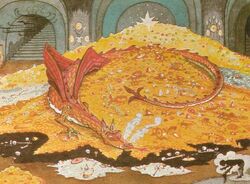
Smaug in the original illustration by J.R.R. Tolkien.
In TA 2770, Smaug came from the mountains in the north, drawn by great wealth amassed by the dwarven kingdom of Erebor, which included gold, gemstones, mithril, silver, pearls, the many-faceted crystals of emerald, sapphire and diamond, and the famed Arkenstone. Seeking to claim the mountain and its treasures for himself, Smaug completely destroyed the neighboring city of Dale in a great firestorm before turning to Erebor itself, smashing through the great doors of the Lonely Mountain, slaying those who resisted him and forcing the surviving dwarves into exile.
For two centuries, Smaug ruled the Lonely Mountain uncontested, lying within the great treasure hoard of Erebor and ensuring no one entered the mountain in an attempt to steal from him. The surrounding doman became a scarred wasteland known to the dwarves and men as the Desolation of Smaug, and the city of Dale remained a blasted ruin and a grim reminder of the dragon's terrible power. Yet in the year TA 2941, a company of fourteen adventurers consisting of twelve dwarves, the wizard Gandalf, the hobbit Bilbo Baggins, and led by the heir of Erebor, Thorin Oakenshield, entered Smaug's mountain lair by a secret door in a daring attempt to reclaim the mountain from the dragon.

Smaug having a conversation with Bilbo Baggins.
Bilbo, the company's appointed "burglar," is sent into the treasure chamber alone in an attempt to stealthily gather intel and steal what he can without waking Smaug. Once there, Bilbo is surprised to find that Smaug was much larger than he had expected and covered in impenetrable armor, save for his underbelly. Aware of this vulnerability, Smaug deliberately spent years sprawled on the wealth of his hoard, allowing diamonds and hard gemstones to be embedded into his belly, armoring his only weakness. However, while examining the dragon, Bilbo noticed a single bare patch on the monster's left breast, nearest his heart. With this invaluable information, he escaped the dragon's lair and returns to the dwarves, sharing his discovery of Smaug's weakness with them, unaware that he was overheard by a thrush, who carried the secret to Bard the Bowman in nearby Esgaroth, also known as Lake-town.
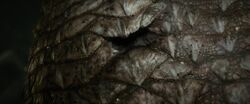
Smaug's missing scale.
Returning to the treasure chamber, Bilbo attempts to steal a single cup, but its theft is immediately noted by Smaug, who awakens from his slumber. Amused by the Hobbit, Smaug converses with Bilbo, attempting to deduce his origins and purpose in the mountain. He quickly surmises that Bilbo was aiding Thorin and the rest of the Dwarf company in an attempt to steal back the Arkenstone and reclaim the Mountain. Smaug flies into a rage, erupting from the mountain in a fiery wrath and loosing his flame upon the land. He flies to Esgaroth upon the Long Lake and devastates it. In the midst of the wreck, Bard the Bowman, heir to the throne of Dale, does his best to rally men to repel the dragon's assault. Bard, guided by his knowledge of Smaug's secret weakness, fires a black arrow into the beast's vulnerable spot on his belly. Roaring in fury and pain, Smaug falls from the sky and crashes into the flaming ruins of Lake-town, his death signaling the end of the presence of dragons in Middle Earth.
After Death

Smaug flies to Laketown.
After Smaug's death, Thorin and Company claimed the treasures of Erebor as theirs by birthright. This created a conflict with Bard and the Elvenking Thranduil of Mirkwood, each of whom wanted a portion of the gold as reimbursement for all the damage Smaug had caused their kingdoms over the years. Thorin refused to share the treasure and, as a result, they both declared war on him.
It is said that a vast fortune in gemstones lay with Smaug's rotting carcass amongst the pilings of old Lake-town, but few had the courage to dive for them in later years. With no Dragon to contend with, the survivors of the town rebuilt on dry land next to the lake.
Etymology
The dragon's name, Smaug, derives from the Old English smeag (of or pertaining to a worm), which is related to the past tense of the primitive Germanic verb smugan (to squeeze through a hole). The diphthong "au" in Smaug is pronounced like the "ou" in sound or house, though the name is often erroneously pronounced 'Smog', most notably in the Rankin/Bass animated movie.
Smaug's name in Tolkien's language of Dain, Trâgu, is similar to the Norwegian word for dragon, drágë.
Size
Smaug's actual size is indeterminate as it is never explicitly mentioned in the The Hobbit. In The Atlas of Middle-Earth by Karen Wynn Fonstad[1], Smaug is said to be about 20' meters' (65 feet) in length. This measurement corresponds with drawings by Tolkien in which Smaug seems to be around 25 meters (86 feet). For the size described in the film works, see below.
It is unclear whether Smaug, the largest specimen in the Third Age, would compete in mightiness to his ancestors of average size in the First Age, though he was clearly smaller than Ancalagon, the largest known dragon to have existed.
Abilities
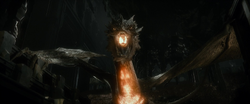
Smaug getting ready to shoot fire at Bilbo.
Being a fully-grown dragon, Smaug was both massive and powerful, possessing physical strength great enough to crush stone with ease, as seen by his attack on Erebor. He was able to fly thanks to his large wings, and had the ability to breath streams of searing hot flame from his mouth. Some comments in The Hobbit imply that his entire body was imbued with fire, as he was seen to glow in the darkness of the Lonely Mountain's depths, and his usual paths were said to have been "smoothed and slimed" (i.e. melted) by his passage.
Like many dragons of Middle-earth, Smaug's monstrous appearance also belied keen senses and a dangerously sharp mind. He had an encyclopedic knowledge of his treasure hoard, immediately registering the theft of a single cup after Bilbo made his first visit to his lair. When the hobbit returned a second time, Smaug was already expecting him by feigning sleep, and immediately declared that he could sense the thief even if he could not see him. Although Bilbo was clever enough not to fall for Smaug's attempts to trick him into revealing his exact position, the dragon used the resulting conversation to plant doubts in Bilbo's mind, correctly guessing that the "burglar" had allied himself with the dwarves and the men of Lake Town and asking if Bilbo had ever considered the logistical difficulties of getting his share of Smaug's treasure back to his home.
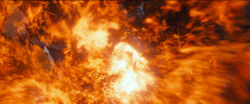
Fire breath, seen in the film
Defensively, Smaug's reddish-gold scales rendered him impervious to nearly all weapons, but his underbelly was relatively soft and vulnerable. To compensate for this, Smaug took to sleeping upon the gathered treasure of the Lonely Mountain, allowing bits of gold and jewels to embed themselves in his body. This "diamond waistcoat" was intended to cover Smaug's only physical weak spot, but when Bilbo Baggins confronted the dragon in his lair, he discovered a bare patch on the left side of his chest. Bard was told this by an ancient thrush that overheard Bilbo relating this information to the dwarves, enabling him to defeat Smaug by shooting his Black Arrow into the bare patch.
Personality
Smaug is portrayed as being psychopathic, arrogant, and greedy, possessing an unquenchable desire for gold. His most distinguishing characteristic (aside from his greed) is his arrogance, as Smaug proudly boasts of his superiority and impregnability to Bilbo during their encounter. However, this proves to be his downfall, as he unwittingly reveals the weak spot in his chest to Bilbo when showing the Hobbit how he had willfully coated his underbelly in treasure to protect it.
Smaug seems primarily motivated by personal greed rather than a desire to do evil, and does not seem to serve any allegiance other than his own. While he does ruthlessly destroy Dale and lays waste to the dwarves of Erebor during his attack on the Lonely Mountain, once he has assumed dominion of the region he seems content to allow the rest of Middle Earth to go about its business, so long as he or his treasure remains undisturbed. Highly intelligent, Smaug appears to possess a rather sardonic sense of humor, darkly mocking Bilbo while they converse within Erebor's treasure chamber. Smaug seems to dislike dwarves, considering them to be weak and pathetic creatures far beneath him, making unfavorable comments about Thror and showing no remorse over his slaughter of their kind and claiming of their kingdom. While conversing with Bilbo, Smaug is also able to quickly surmise the reason for Bilbo's presence in Erebor, and also correctly deduces that the dwarves received aid from the men of Esgaroth in reaching the mountain.
Portrayal in adaptations
The Hobbit film trilogy
- "I am fire. I am...death."
- —Smaug, Desolation of Smaug
Smaug is voiced and interpreted with performance capture by Benedict Cumberbatch in Peter Jackson's three-part adaptation of The Hobbit. Smaug is presented with a long head, red scales, enormous wings, and gleaming yellow eyes. The dragon has a deep, resonant voice with an underlying growl.
- "I am king under the mountain."
- —Smaug, Desolation of Smaug
Smaug appears in the prologue of the first film, The Hobbit: An Unexpected Journey, described as a "fire drake from the north" before taking residence in Erebor. His full appearance was not shown as only parts of him were glimpsed as he is flying over Dale and partially obscured by the treasure in Erebor. He is featured mostly off-screen, only visible are his legs, tail, a small part of his head, and his wings as he flies, which is consistent with Tolkien's illustrations, and his eye, which can be seen in the final scene of the film. In addition, Smaug is a topic of discussion amongst the White Council as Gandalf cites his reason to support Thorin Oakenshield's quest.
In the second film, The Hobbit: The Desolation of Smaug, Smaug is awoken as Bilbo hunts for the Arkenstone amongst the vast treasure pile of Erebor. Although Bilbo uses the One Ring to remain out of sight, the dragon is immediately made aware of his presence by his scent. As he searches for Bilbo, he hints at an awareness of the Ring in Bilbo's possession, claiming that he senses that Bilbo has something "made of gold, but far more precious," which in turn forces the hobbit to remove the ring in front of him. During their conversation. Smaug reveals that he had already known about Thorin's plans to reclaim the Lonely Mountain (possibly because of the Thrush knocking the entrance to the heart of the mountain in the first film). Smaug also reveals his knowledge of the growing threat from Sauron (though he doesn't name him), stating that the quest to reclaim Erebor is ultimately futile as Sauron is preparing to openly declare himself once more. Smaug quickly discerns the Hobbit's true intentions to steal the Arkenstone from him, and claims that he is almost tempted to let Bilbo take it in order to watch it consume Thorin as it did Thror. At this point Smaug tires of their cat-and-mouse banter and immediately tries to eat Bilbo, but Bilbo uses the ring to evade him, causing Smaug to fly into a rage and unleash a torrent of flames around the treasure chamber in an attempt to roast the hobbit alive before he can escape.
Smaug catches up to Bilbo and the dwarves, but they manage to elude him, and he begins silently stalking the abandoned halls in search of them. Upon realizing he is blocking their only path out of the mountain, the dwarves hatch a desperate plan to lead Smaug to Erebor's forges in hopes that they can trick him into rekindling the smelting vats with his fire breath. They reveal themselves to Smaug, initiating a perilous game of cat an mouse through the halls of the mountain, doing everything in their power to encumber the pursuing dragon as they race towards the entrance to Erebor. As Bilbo leads the dragon inot the Gallery of the Kings, he is quickly overrun by Smaug, who deduces that Bilbo and the Dwarves were aided by the men of Esgaroth, and leaves to destroy the town. As he is leaving, Thorin appears and taunts him, unveiling an enormous, freshly casted golden statue of a dwarf, which distracts the greedy dragon long enough for the statue to melt into liquid gold and engulf him. However, Smaug survives the scalding gold and erupts from the molten pool, roaring that he will show the dwarves what revenge really is. He then breaks through the walls of the mountain, shakes off his gold coating, and takes flight. Smaug flies off towards Lake-town, and the film ends with him uttering "I am Fire, I am.....Death!" as he soars towards the unsuspecting town, leaving Bilbo and the others in horror at what they have unleashed.
The dragon was created with key frame animation, meaning it was animated by hand, in addition to Cumberbatch's motion capture performance. Weta Digital employed its proprietary "Tissue" software which was honored in 2013 with a "Scientific and Engineering Award" from the Academy of Motion Picture Arts and Sciences to make the dragon as realistic as possible. Cumberbatch aimed for Smaug's voice to be "that bridge between animal and human, something guttural, deep and rasped, kind of dry as well because of all the fire breathing." He studied reptiles at the London Zoo to prepare for the role.
Smaug was considered the highlight of the second film of the series with several critics hailing it as cinema's greatest dragon incarnation. Universal praise was also given to the visual effects company Weta Digital and the vocal and motion-capture performance of Cumberbatch for bringing a fully realized personality to Smaug.
Movie Abilities
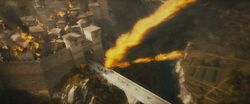
Smaug's liquid-flame in the first film.
It is possible that he can change how his fire-breath comes out, depending on the usages. In the first film, his fire was more liquid and napalm-like, which had enough power and mass to shatter stone buildings and its blast could spread on the ground. In the second film, his fire is somewhat of a more typical fire or gas-fueled flamethrower-like with immense firepower enough to engulf his own body. It is possible that his breath in the second movie was normal fire because his priority was to kill the intruders, and not to cause destruction, understandably his treasures.
Movie Size
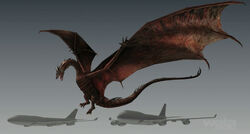
Smaug's size comparison with Boeing 747 in making.
In the film adaptations, Smaug dramatically increased in size. His actual size was unknown until his image designed on Air New Zealand B777 was revealed to be 54 meters in length. However, this was the length of painting itself, not his actual size. There is estimations of him to be longer than 60 meters in length and wider than 50 meters in wingspan[2]. Though in the comments made in the makings, his size is mentioned to be 130 meters in length and "bigger than two jumbo jets"[3].
In original concepts, Smaug was supposed to be more menacing and gigantic than in the actual movie, and these changes were due to make its character more 'special'. The same trait happened with Gollum as well[4]. In pre-publishing comments by Joe Letteri, the Oscar winning VFX supervisor from Weta digital, Smaug was said to be "twice as big as a Boeing 747", calculating over 141m in length[5].
Film Continuity
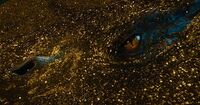
Smaug under his treasure.
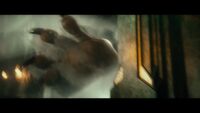
Smaug's "foreleg" seen in the first film by ArchedCory.
In the prologue of the theatrical release of An Unexpected Journey, Smaug had six limbs (four legs and two wings), which was his initial design, before it was changed for the next film, where the Dragon is revealed as having four limbs (two back legs and two front legs with his wings attached).
The film also deviates from the book in portraying Smaug's underbelly as being heavily armored as the rest of him, rather than being artificially protected by a coat of gold and gems. The bare patch that Bilbo notices is a single missing scale instead, broken off during his attack on Dale, by one of the Black Arrows fired by Girion.
Voice Dubbing actors
| Foreign Language | Voice dubbing artist |
|---|---|
| Portuguese (Brazil) (Television/DVD) | Ricardo Schnetzer |
| Spanish (Latin America) | Carlos Segundo |
| Spanish (Spain) | Ivan Muelas |
| Italian (Italy) | Luca Ward |
| Hungarian | Peter Haas Vander |
| Czech | Aleš Procházka |
| French | Jérémie Covillault |
| German | Sascha Rotermund |
| Polish (Poland) | Jacek Mikołajczak |
In Gene Deitch's version (1966)

Slag the ancient monster.
Smaug in this version was mentioned to be 'Slag', 'the ancient monster of the Earth'. The monster has a tail which can pick a object. He was slain by Bilbo, Thorin's company, and 'Princess Mika' (an original character who was one of three survivors from Elebor and Esgaroth along with Thorin) very themselves, by shooting a large arrow which the heart-shaped Arkenstone was attached with as an arrowhead, from a catapult.
Rankin/Bass' The Hobbit
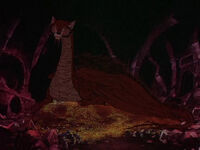
Smaug in the Rankin and Bass animated version from 1977.
In the 1977 animated version of The Hobbit, Smaug was voiced by Richard Boone, and his head looked cat-like.
Video games
- In the 2003 video game release, Smaug was voiced by James Horan.
- Smaug will also appear in the upcoming Lego video game of LEGO The Hobbit to be released 11th of April 2014.
Trivia

Six limbed Smaug in original concept.
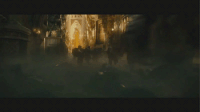
Smaug's forelegs seen in the first film.(gif)
- Most notably, Smaug was apparently a four-legged western dragon in the first film[6], but to follow the description in the book, referring to him as a "worm", he was redesigned to be a more snake or bird like wyvern-type dragon in the second film[7]. In the Blu-ray extended edition of the first movie, his forelimbs were changed to winged-arms[8].
- His body parts have also been altered from what he looked like in the first movie[9].
- In the movie, his chest and neck glow orange before he breathes fire. This is similar to Godzilla as his backfins glow before he uses his atomic breath. This as well happens in the Beowolf movie, where as Beowolf's Demon offspring in dragon form had the effect when he breathes fire.
- Smaug in the movie was designed to be 'multicultural', combining characteristics from dragons around the world[12].
- A kite resembling Smaug appears in the prologue of the first film.
- Some of his early designs largely resembles that of the Balrog in the movie series, as one has horns and bulk neck resembling that of Balrogs, and his eyes and inside of mouth glow incandescence white like a jack o'lantern in another one.
- Smaug in the movie was somehow aware of Black Arrows with their proper noun.
- Smaug is one of regular rankers in the "Richest fictional characters" by the Forbes. According to Michael Noer, writing for Forbes Magazine, Smaug is the wealthiest fictional character, with a treasure having a calculated valuation of over 62 billion dollars,[13] although he can't actually spend any of it!
- The scene where Thorin lands on Smaug's nostril is maybe a Peter Jackson's self-homage to his previous work, the King Kong (05'); to the scene where Ann Darrow accidentally landed on the nostril of one of Vastatosaurus Rexs
Gallery
 |
 |
 |
 |
 |
 |
 |
 |
 |
 |
| File:Bed72e3b-b9f8-4eb7-9b05-ca34156b85fd dungeons-dragons-turns-40.jpg |
 |
 |
 |
 |
 |
 |
 |
 |
 |
 |
 |
 |
 |
 |
 |
 |
 |
 |
 |
 |
 |
 |
 |
 |
 |
 |
 |
| This page uses content from Wikipedia. The original article was at Smaug. The list of authors can be seen in the page history. As with The One Wiki to Rule Them All, the text of Wikipedia is available under the Commons Attribution-Share Alike license. |
References
- ↑ Karen Wynn Fonstad, 2002, The Atlas of Middle-Earth, Houghton Mifflin
- ↑ http://www.theonering.net/torwp/2013/05/11/71530-analysis-just-how-big-is-jacksons-smaug/3/
- ↑ http://www.fxguide.com/quicktakes/behind-the-scenes-of-weta-digitals-smaug/
- ↑ http://www.mtv.com/news/articles/1719502/smaug-hobbit-fx-explained.jhtml
- ↑ http://www.hollywoodreporter.com/behind-screen/hobbit-desolation-smaug-wetas-joe-665531
- ↑ http://thorinoakenshield.net/2013/12/24/the-anatomy-of-smaug/
- ↑ http://atolkienistperspective.wordpress.com/2013/11/13/dragons-vs-wyverns-the-question-of-smaug/
- ↑ http://atolkienistperspective.wordpress.com/2013/11/13/dragons-vs-wyverns-the-question-of-smaug/
- ↑ http://www.theonering.net/torwp/2013/09/05/78516-what-smaug-might-look-like-a-concept/
- ↑ http://blogs.scientificamerican.com/but-not-simpler/2014/01/02/smaug-breathes-fire-like-a-bloated-bombardier-beetle-with-flinted-teeth/
- ↑ http://www.mtv.com/news/articles/1719502/smaug-hobbit-fx-explained.jhtml
- ↑ http://www.mtv.com/news/articles/1719502/smaug-hobbit-fx-explained.jhtml
- ↑ Noer,Michael. (23 April 2012). How much is a dragon worth: Revisited. Forbes.com. Forbes. Retrieved from: [http://www.forbes.com/sites/michaelnoer/2012/04/23/how-much-is-a-dragon-worth-revisited/.
- ↑ http://cgcj.wikia.com/wiki/The_Hobbit
- ↑ http://conceptartorg.deviantart.com/art/Smaug-146371400
External link
 Smaug at Tolkien Gateway
Smaug at Tolkien Gateway Smaug at Wikipedia
Smaug at Wikipedia- Anatomy of Smaug by ArchedCory






